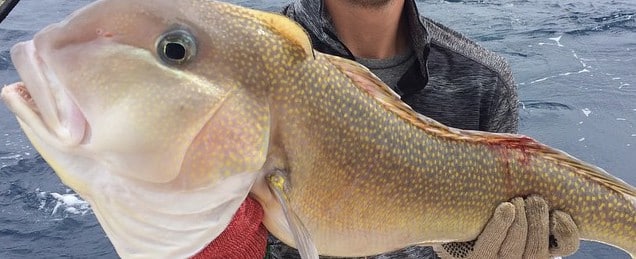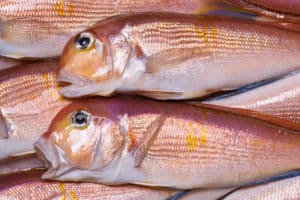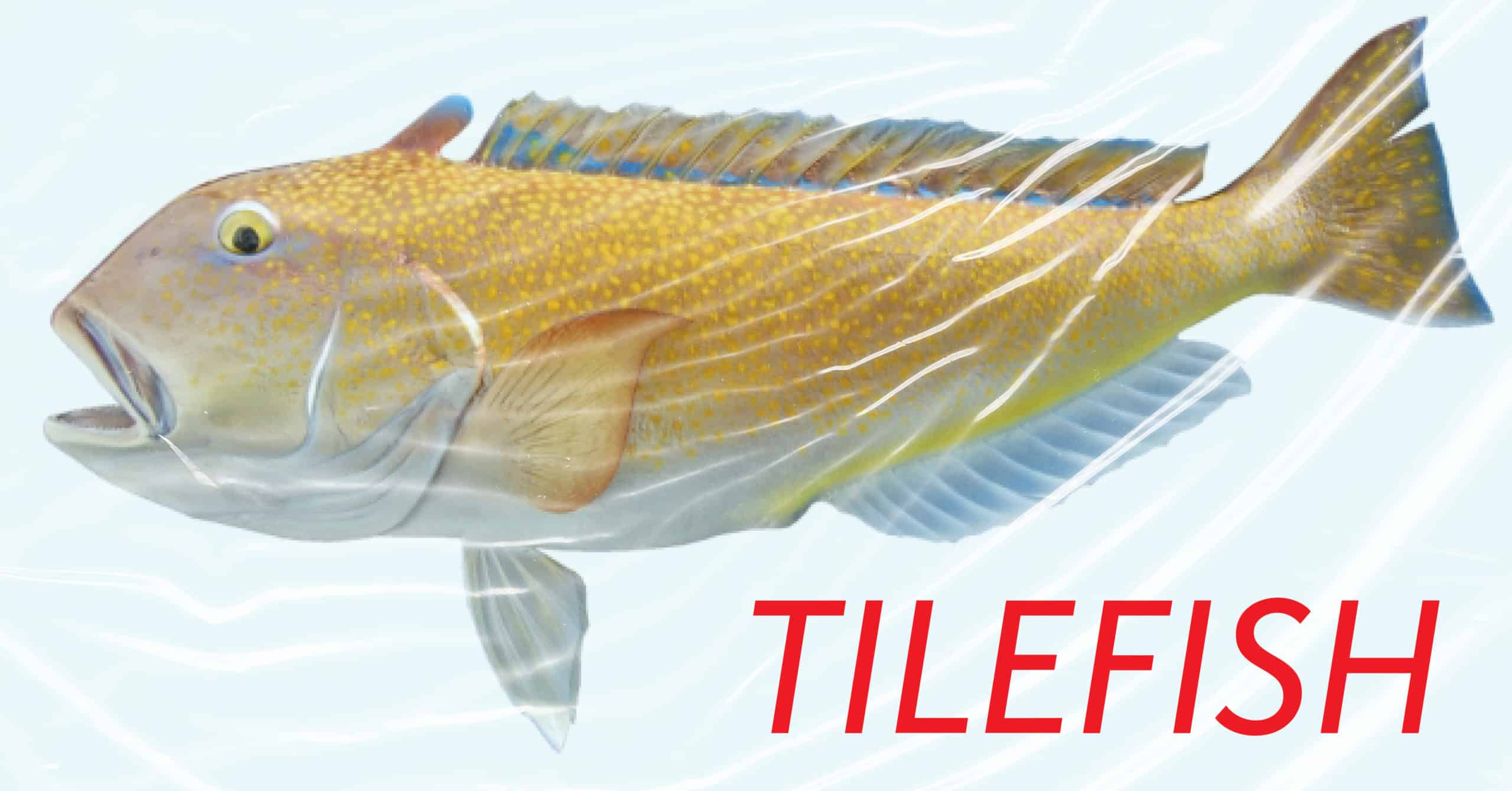One of the biggest requests for a blog topic has been the Gulf of Mexico Tilefish. This is not a sport fish that is exclusive to this region. However, it can definitely be found in deep, cold waters in the Gulf area. It’s a fun fish to catch and it’s as tasty to snack on as it is funny to look at.
The Lowdown on the Mysterious Gulf Water Tilefish
Tilefish are something of a novelty in the Gulf region. This is because, unlike a tuna fishing charter, most companies won’t book a trip solely to catch this species. This is mostly because this fish can be caught either before or after more common species. They aren’t exactly unique or in big enough numbers to catch by themselves.
The tilefish is a very interesting character. Hunting for them can add a unique twist to your charter fishing trip. The tilefish is always found in the deepest, coldest part of the Gulf. They pool in waters that are usually about 600 to 700 feet deep. However, they can descend down to 900 feet if they feel the need.
Tilefish have a distinctive “derpy” look that can provoke laughter at first sight. But they are also renowned as one of the tastiest and most satisfying meals that the sea can provide. For this reason, they are highly sought after by Gulf seafood lovers with elevated tastes. Now is your chance to get up to speed on this very tasty subject.
About the Tilefish
The outer continental shelf and slope of Nova Scotia, Canada to Suriname are home to golden tilefish. The U.S. golden tilefish fishery is managed from Maine to Virginia. Most of the fishery is located between Nantucket Island in Massachusetts and Cape May, New Jersey.
Although longline is the most common type of commercial fishing gear, handline, rod and line, as well as trawl, are all allowed. The recreational golden tilefish fishing fleet is limited to rod and reel.
Golden tilefish is primarily for human consumption. It is also used in sushi.
U.S. wild-caught gold tilefish is a smart choice for seafood because it is responsibly harvested and sustainably managed under U.S. regulations. You can find the 50 CFR Part 648 subpart N implementing regulations.

A Tilefish’s appearance
Tilefish are sometimes called “the clown of sea” since they are generally a very colorful fish. Their backs are a dazzling blue-green color with flecks of yellow and gold. Their heads are blue and rosy under their eyes. The pectoral fins of tilefish have a sepia color, while their anal fins are purplish-blue. The large crest on the head of golden tilefish makes them easily identifiable from other members in the tilefish family.
Biology of a Tilefish
Although tilefish grow slowly, they can reach up to 43 inches in length, the average size of tilefish is 24 inches. Their life expectancy is up to 46 (females), and 39 (males) years. Although these are the oldest known tilefish, radiometric dating techniques suggest that tilefish can live up to 50 years. Tilefish can reproduce once they reach 13 inches in length and 3 pounds (approximately 2 – 4 years).
Tilefish spawn in the Atlantic from March to November and in the Gulf of Mexico from January through June. Spawning peaks are in June (Mid-Atlantic), and April to June, (South Atlantic and Gulf of Mexico). When they spawn, females can release between 2 and 8 million eggs.
Tilefish eat shrimp, crabs and snails while they are at the bottom of the ocean. Spiny dogfishes, monkfish, spiny catfishes, conger eels and large bottom-dwelling Sharks (such as dusky or sandbar sharks) prey on juvenile tiles.
Where do Tilefish live?
Tilefish can be found on the U.S. East Coast along with the Gulf of Mexico’s upper continental slope and outer continental shelf. They are found most frequently from Nantucket Island in Massachusetts to Cape May in New Jersey.
The Golden Tilefish is Truly One of a Kind

Tilefish
There are many fascinating facts to learn about the Golden Tilefish. But unless you’re a devoted ichthyologist, the main things you need to know are three. First, they look funny. Secondly, they’re very tasty. And third, you’re vacationing in the Gulf soon? Great! This is the perfect place to get on a charter boat and go fishing for them.
When all is said and done, the Tilefish is a beautiful, if very distinctive, member of its species. The sides of the average specimen are aqua blue with light green highlights. When you turn them on their backs, you’ll quickly notice a unique blend of blue mixing into yellow and then blue shading into green.
There are a few other distinctive features that will quickly identify a Tilefish. They tend to have a reddish-pink band that runs down their side. This band blends into a silver and yellow belly. Overall, they are golden in hue. And, according to the most experienced seafood lovers, they are a delicious dish that everyone should sample.
Fishing for Tilefish is a Day Long Adventure
If you are ready for a day-long adventure out on the open Gulf water, the Tilefish may just be your ticket. The Tilefish tend to live in a series of well-placed burrows deep in the muddy bottom of the Gulf. They tend to dig out small cave structures that they can then use for shelter from their predators.
The Gulf sunlight only just reaches them at the depths they prefer. However, they still prefer to feed and congregate during the daytime. They can usually be found en masse between the hours of 10 am and 3 pm. During this time, they tend to swim in a very slow and calculated manner, making them tricky to locate and hook.
Unlike most game fish and most Gulf fish in general, the Tilefish doesn’t tend to swim in large schools. They do congregate but only in small groups. This makes catching one a bit of a trick to pull off. But even if you don’t get lucky, there are still plenty of other fish to catch at this depth.
There are several species of grouper, especially the snowy grouper, that can be found in the same general area as the Golden Tilefish. And, of course, there are lots of other species that you can easily hook on to. You won’t have any trouble finding lots to do out on the water.
Tilefish Taste
The golden tilefish is low-fat and has a delicate sweet taste similar to crab or lobster. Although tilefish is almost always sold whole, it can also be sold in filets or steaks. When frozen, it will come with skin-on, boneless filets.
The price of tilefish is determined by its size. Larger fish are more expensive. While smaller tilefish may be more affordable than larger fish, buyers should note that they have less shelf-life and soft flesh. Tilefish yields thick filets with a row of pin bones and raw tilefish flesh is light and pinkish but turns flaky and white when cooked.
How to cook Tilefish
There are many different ways to cook tilefish. They can be pan-seared, breaded and fried, or oven-roasted. A quick Google search reveals many different recipes to choose from.
One of the most popular is a pan-seared tilefish with garlic herbs and lemon. Our favorite way, however, is to broil them.

Book Your Tilefish Charter Fishing Trip Today
If you are ready to enjoy the charter fishing trip of a lifetime, let us know. We are booking trips now. Louisiana offshore fishing charters are a great way to relax, unwind, and enjoy yourself on the open sea. It’s also a fantastic way to relax with family members, friends, and new associates from the business world.
Whether you’re an old hand on the sea or a complete newbie, you’re going to love our upcoming Gulf Coast chartered fishing trips. Our crew is skilled, knowledgeable, and extra friendly. Get in touch with us today to learn more about what we can do to make your next Gulf trip the adventure of a lifetime.




